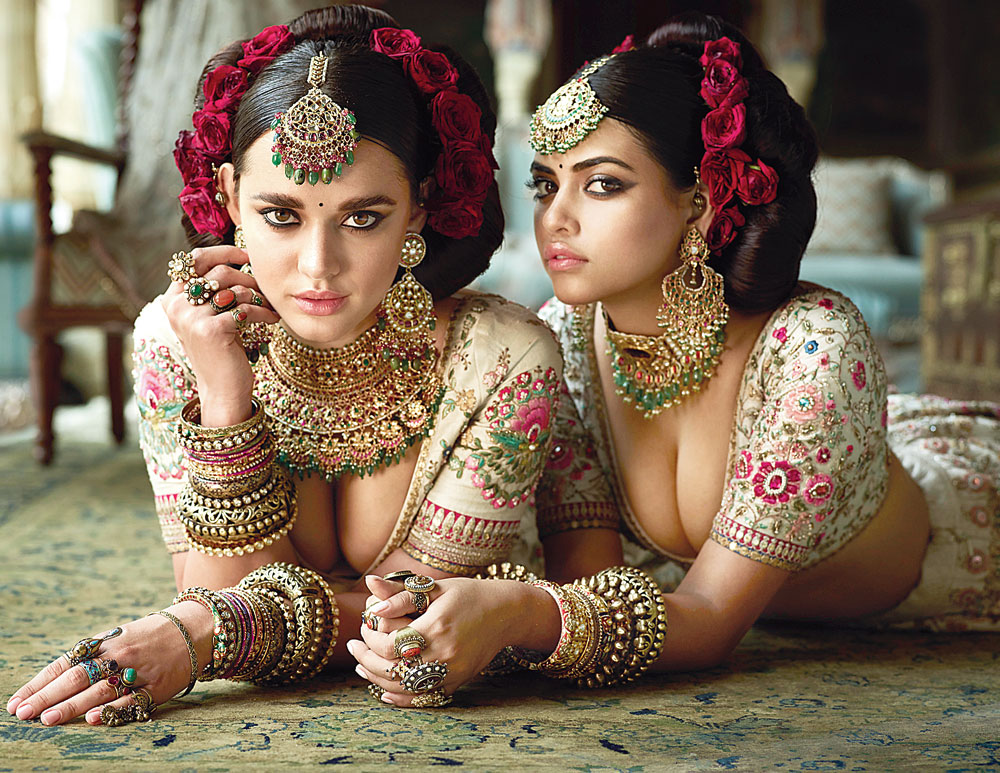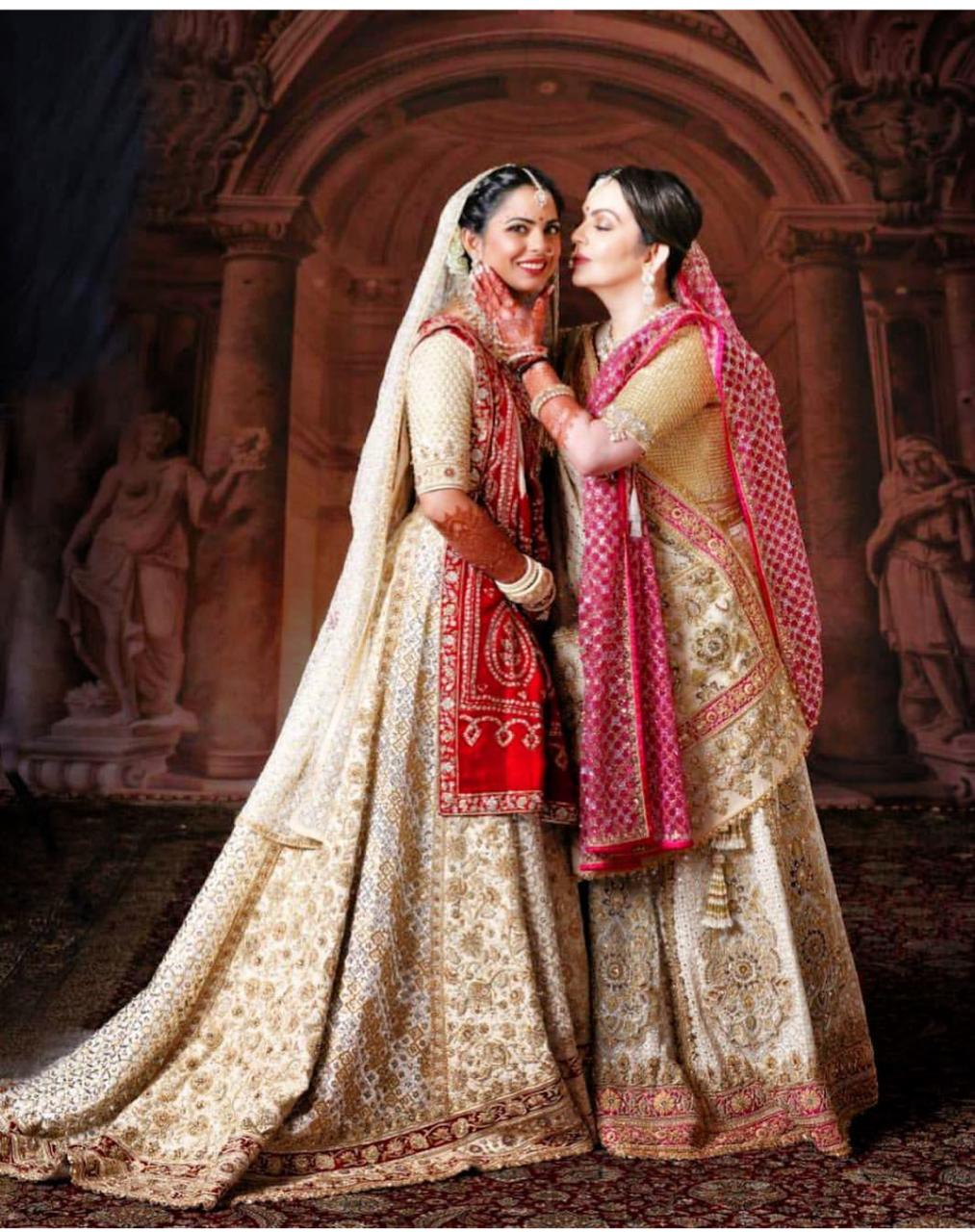How did your love affair with the sari start?
I started Raw Mango in 2008. Before that I wanted to go abroad to study, and come back and do textile designing. To pool in money, I took up a government project that used to pay me Rs 30,000 a month. That’s how I got introduced to Chanderi. And when I went there, I fell in love. There were offers from two-three colleges in London, but I never went.
I would always wonder, can design change something? Can design bring back the sari to another world? How does design solve a purpose? I always wanted to make the sari the hero because I felt it was the need of the time. As a countryman, that is my identity. There were beautiful designs, so what was the problem? I was a nationalist since then and I think it has become a bad word today.
Today I also understand the value of the handmade. You look at things differently. When you are buying old textiles or a statue, you value it all the more. That system of valuing, I wanted to change in everyone’s head. Why are only Italy-made shoes valuable and not your jootis? Why are made-in-Italy suits so expensive and not the Indian ones? So, when people say handloom is expensive, I say why not?! Why do you need to suffer because you are doing handloom? Paisa galat cheez hai, I disagreed with that also. I wanted to work on my terms. I realised I would have to make money, which I could invest in my innovation and research. That was my model.
I named it Raw Mango because I love the beauty of imperfection. And I wanted a bit of a surprise... Indian, but very different and edgy. You also feel that tangy taste!
I started off as a one-man army. Then there were three people for two-and-a-half years. Earlier, I was in a very small house in Vasant Kunj (in Delhi) for five years. Then I went to Chhattarpur (on the outskirts of Delhi). People said no one would come; now it has become so happening. Everything happened with a lot of risk. Everyone works hard, but I think I was lucky. I happened to be at the right moment.
I did Chanderi, mushroo, brocade lehngas; now, so many people are doing brocade. You feel good. Heer (his festive collection) was not shot in a palatial place. We did it in a house. We have no almirahs or mannequins in the stores, the saris are all in the cupboards.
Do you remember the first sari you designed?
It was a beige sari with a gold border, tone-on-tone. Then there was a pink-and-red striped one with a silver border. There was a white sari with a one-inch silver border with small checks on the pallu. There was one sari in organza and cotton vertical stripes, tone-on-tone. Then I did my bird sari, which became a hit. There was a mango on the sari too. Over the years we have retained the solid-hued ones. I started with Chanderi, then I went to Benaras, after that it was mushroo. Then I did Bengal jamdani and I still do it. You evolve every single day.
Why do you think your saris became so popular?
I think my saris became cool because I edited a lot through design. I made them so simple. The bold colours and combinations, the uniqueness of the motifs, the layout of the sari, the different uses of zari and the drape of it. I was washing every single sari; it wasn’t starched, it was flowy on the body. And that’s what the woman wanted because she’s always on the move.
What exactly do you love so much about the sari?
The sari is so romantic. When I see a Marathi woman in her sari with a khand blouse, or a cotton sari in Bengal or a lady in a Kanjeevaram with flowers in her hair, it is something else. Bengalis have great aesthetics. I want to see that in the crowd. I want to see at least 15 per cent women wearing cotton saris beautifully. Sometimes I miss that when I come to Calcutta. The red bindi... that whole romance of Calcutta that I have in my head. You fall in love with it. I am not saying every woman needs to wear a sari but till I die, the sari will be my first love. More than a particular weave, I like the simple aesthetics of the sari. There is a kind of imagery in my head. I love the sensibility of a Kanjeevaram with a gold border, or a white-on-white jamdani.
Do you think the sari has shed its ‘uncool’ tag?
I think the idea of modernity and coolness has changed. People think a sari is not modern, but a sari is actually an evolved outfit. You don’t have to worry about sizes and you can tie it in 50 different ways! Modern is a mix of many things. Who you are, the way you wear things with confidence. My sister always wears a sari with a bustier, she feels a sari doesn’t require a blouse. That’s what they wore here before, in Bengal and Odisha.
I think we also need to come out of that phase where wearing a sari is a statement. I don’t believe in it. This ‘in’ and ‘out’ business is bad. There is a culture you have inherited, you need to belong where you come from.
People definitely buy saris for their trousseau, but my idea of a sari is not for the trousseau alone. I’ll be unsuccessful if I only become a wedding brand. That’s why in my store, there is a sari worth Rs 5,000 also, because the idea that a sari is to be worn only at shaadis annoys me. I am not imposing, but you can wear it to a night-out or a dinner. Find your own reason and comfort.
You have launched your garments line too
In 2014, I started doing garments, in a bid to reach out to more people. I could also use many more looms. And a lot of young girls come and buy now. I am doing objects with glass, loha and bronze. I want to explore, but the idea of the design will remain the same. If I can retain that sensibility irrespective of what I make, toh main hoon.
I am all about revival as well as innovation. Some of my collections, like Monkey Business and Cloud People, did not have traditional motifs. Then again, I would do one which is completely traditional. I think life is about that — balance. This country needs the right representation and a balance, which I try while I am designing. Sometimes I think India mein minimalism hotey the kya, or am I forcing it?
What’s coming up next?
We are working on our summer collection that features thousands of flowers. We have also done Lucknow chikankari. The experiment continues. I wouldn’t say I would ever be able to master textile. I don’t think anyone can. One lifetime is not enough for one textile.
Why do you maintain a distance from the fashion industry?
I don’t belong in this world of fashion. When you say people think twice before touching my pieces, I feel bad. Being expensive is okay because of the craftsmanship, but not because it is fashionable. Sometimes, “fashion designer” sounds like a gaali to me. Call me a textile designer or someone who is working with textiles. I don’t want to belong here, I am in a happy space. I don’t care what they say, but yeh anger bana rehna chahiye.
Tell us something people don’t know about you…
I love dancing, we do crazy parties. I buy a lot of books but I don’t get the time to read them. I buy old textiles and antiques all the time.
Sanjay Garg is a difficult man to interview. Simply because you cannot pin him down. If and when you win the catch-me-if-you-can chase with him, you realise you don’t know him. He is not a man of few words, as you had made him out to be over phone, and that his brusqueness is more of a shield from the world of “the fashionable”.
Hailing from Mubarikpur, a small village in Alwar district of Rajasthan, Sanjay studied textiles at the Indian Institute of Crafts and Design (IICD) in Jaipur and left home after school because there was no college in his village. “One of my cousins was into design and that’s how I was introduced to it. I was like, one can actually study design?! I was doing my MCom, I left it midway. This was in 2001, I was 21. But let me tell you, I had it in me,” he says, when we finally meet at Wedding Diaries in Swabhumi.
“I always simplified things, I always liked minimalism, but I didn’t know how to put it in design. Education gave me that formula,” he adds.
Garg was passionate about sketching from a very young age, copying illustrations from comic books such as Chacha Chaudhary and Pinki; convincing his parents about pursuing a career in fashion was a hurdle, though. “My father had a small business of fertiliser and seeds. They were like, it’s okay if you are not able to support us, but how will you support yourself? They were not aware of the possibilities, even I wasn’t aware. I don’t think my parents still do. Anything they see handwoven, they think it is Sanjay Garg. My sister knows why I am doing what I am doing.”
The turning point of his career was his stint with the National Institute of Fashion technology (NIFT), Delhi, which accepted him with his “broken English”. “I didn’t know English but I realised that the confidence of speaking broken English was everything. The confidence of knowing that you do not care about it… I stopped learning new words. How does it matter? What you communicate matters.”
His journey from Mubarikpur to the world of high fashion is like a fairy tale and Garg is proud of the change in thinking his success has brought about. “All I am saying is, you just need one example. In Haryana, if one takes up boxing, many follow in their footsteps. The confidence comes because they relate to you.”
The man whose muse is the minimal woman, will surprise you with his plea to de-belong and detach. We met the rebel who believes tradition is not the past, it is the future; if not that, then it becomes irrelevant. And there’s only thing that our conversation centres around. No brownie points for guessing it — the sari!
When you started designing, what is it that you had set out to achieve?
I always wanted to change the world and I still want to. I don’t agree with the aesthetic of a woman dressing up too much. Why does she have to carry so much baggage? Bollywood is now going the simple route. Earlier they would deck up top to bottom; they would go minimal when it came to western clothing. So, I would be like, is minimal only a western concept? Does minimalism mean nothing in India?
I would be angry. I disagreed with the system so much. I thought why is a sari not fashion first of all? Why is it not modern? Why is it not for a young woman? Why is handloom not cool? IICD changed my mindset; I learnt that craft was everything.
Favourite motif
That little chidiya, which we don’t see any more
Favourite colour
I like green a lot
Favourite fabric
Mushroo
Actresses whose style I like
Deepti Naval… She really spends time while buying things. Kangana Ranaut… beech mein jab woh aayi thi, bahut courageous thi; when she was experimenting













